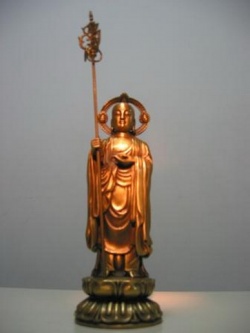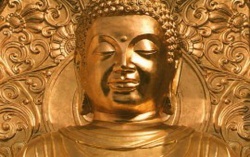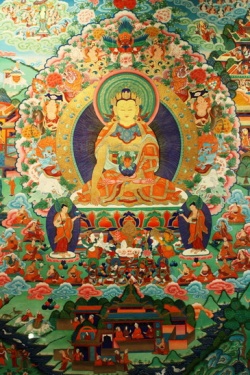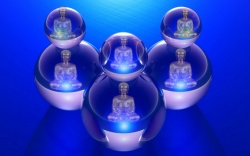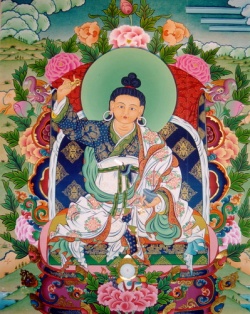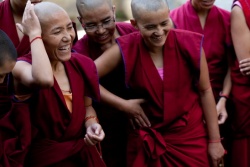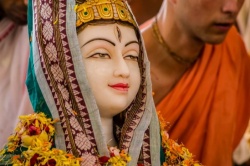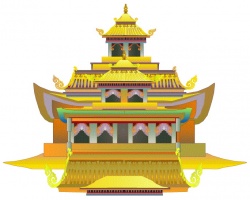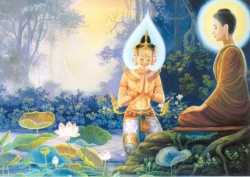Buddha Nature is NOT ''I Am''
Like a river flowing into the ocean, the self dissolves into nothingness. When a practitioner becomes thoroughly clear about the illusionary nature of the individuality, subject-object division does not take place. A person experiencing “AMness” will find “AMness in everything”. What is it like?
Being freed from individuality -- coming and going, life and death, all phenomenon merely pop in and out from the background of the AMness. The AMness is not experienced as an ‘entity’ residing anywhere, neither within nor without; rather it is experienced as the ground reality for all phenomenon to take place. Even in the moment of subsiding (death), the yogi is thoroughly authenticated with that reality; experiencing the ‘Real’ as clear as it can be. We cannot lose that AMness; rather all things can only dissolve and re-emerges from it. The AMness has not moved, there is no coming and going. This "AMness" is God.
Practitioners should never mistake this as the true Buddha Mind! "I AMness" is the pristine awareness. That is why it is so overwhelming. Just that there is no 'insight' into its emptiness nature. Nothing stays and nothing to hold on to. What is real, is pristine and flows, what stays is illusion. The sinking back to a background or Source is due to being blinded by strong karmic propensities of a 'Self'. It is a layer of ‘bond’ that prevents us from ‘seeing’ something…it is very subtle, very thin, very fine…it goes almost undetected. What this ‘bond’ does is it prevents us from ‘seeing’ what “WITNESS” really is and makes us constantly fall back to the Witness, to the Source, to the Center. Every moment we want to sink back to Witness, to the Center, to this Beingness, this is an illusion. It is habitual and almost hypnotic.
But what exactly is this “witness” we are talking about? It is the manifestation itself! It is the appearance itself! There is no Source to fall back, the Appearance is the Source! Including the moment to moment of thoughts. The problem is we choose, but all is really it. There is nothing to choose.
There is no mirror reflecting
Manifestation alone IS.
There is no invisible witness hiding anywhere. Whenever we attempt to fall back to an invisible transparent image, it is again the mind game of thought. It is the ‘bond’ at work. (See Thusness's Six Stages of Experience)
Transcendental glimpses are misled by the cognitive faculty of our mind. That mode of cognition is dualistic. All is Mind but this mind is not to be taken as ‘Self’. “I Am”, Eternal Witness, are all products of our cognition and is the root cause that prevents true seeing.
When consciousness experiences the pure sense of “I AM”, overwhelmed by the transcendental thoughtless moment of Beingness, consciousness clings to that experience as its purest identity. By doing so, it subtly creates a ‘watcher’ and fails to see that the ‘Pure Sense of Existence’ is nothing but an aspect of pure consciousness relating to the thought realm. This in turn serves as the karmic condition that prevents the experience of pure consciousness that arises from other sense-objects. Extending it to the other senses, there is hearing without a hearer and seeing without a seer -- the experience of Pure Sound-Consciousness is radically different from Pure Sight-Consciousness. Sincerely, if we are able to give up ‘I’ and replaces it with “Emptiness Nature”, Consciousness is experienced as non-local. No one state is purer than the other. All is just One Taste, the manifold of Presence.
The ‘who’, ‘where’ and ‘when’, the ‘I’, ‘here’ and ‘now’ must ultimately give way to the experience of total transparency. Do not fall back to a source, just the manifestation is sufficient. This will become so clear that total transparency is experienced. When total transparency is stabilized, transcendental body is experienced and dharmakaya is seen everywhere. This is the samadhi bliss of Bodhisattva. This is the fruition of practice.
Buddha-nature is a Mahayana teaching but without correct understand can lead to an eternalist extreme. Loppon Namdrol says in 2006:
Loppon Namdrol:
Were the Buddha to teach such a doctrine, it might be so. However, in the Nirvana sutra is states quite plainly the following:
That is called ‘Buddha-nature’ because all sentient beings are to be unsurpassedly, perfectly, completely enlightened at a future time. Because afflictions exist in all sentient beings at present, because of that, the thirty two perfect marks and the eighty excellent exemplary signs do not exist”.
Here, the Nirvana sutra clearly and precisely states that buddha-svabhaava, the "nature of a Buddha" refers not to an actual nature but a potential. Why, it continues:
"Child of the lineage, I have said that ‘curd exists in milk’, because curd is produced from milk, it is called ‘curd’.
Child of lineage, at the time of milk, there is no curd, also there is no butter, ghee or ma.n.da, because the curd arises from milk with the conditions of heat, impurities, etc., milk is said to have the ‘curd-nature’."
So one must be quite careful not to make an error. The Lanka states unequivocably that the tathagatagarbha doctrine is merely a device to lead those who grasp at a true self the inner meaning of the Dharma, non-arising, the two selflessnesses and so on, and explains the meaning of the literal examples some people constantly err about:
"Similarly, that tathaagatagarbha taught in the suutras spoken by the Bhagavan, since the completely pure luminous clear nature is completely pure from the beginning, possessing the thirty two marks, the Bhagavan said it exists inside of the bodies of sentient beings.
When the Bhagavan described that– like an extremely valuable jewel thoroughly wrapped in a soiled cloth, is thoroughly wrapped by cloth of the aggregates, aayatanas and elements, becoming impure by the conceptuality of the thorough conceptuality suppressed by the passion, anger and ignorance – as permanent, stable and eternal, how is the Bhagavan’s teaching this as the tathaagatagarbha is not similar with as the assertion of self of the non-Buddhists?
Bhagavan, the non-Buddhists make assertion a Self as “A permanent creator, without qualities, pervasive and imperishable”.
The Bhagavan replied:
“Mahaamati, my teaching of tathaagatagarbha is not equivalent with the assertion of the Self of the non-Buddhists.
Mahaamati, the Tathaagata, Arhat, Samyak Sambuddhas, having demonstrated the meaning of the words "emptiness, reality limit, nirvana, non-arisen, signless", etc. as tathaagatagarbha for the purpose of the immature complete forsaking the perishable abodes, demonstrate the expertiential range of the non-appearing abode of complete non-conceptuality by demonstrating the door of tathaagatagarbha.
Mahaamati, a self should not be perceived as real by Bodhisattva Mahaasattvas enlightened in the future or presently.
Mahaamati, for example, a potter, makes one mass of atoms of clay into various kinds containers from his hands, craft, a stick, thread and effort.
Mahaamati, similarly, although Tathaagatas avoid the nature of conceptual selflessness in dharmas, they also appropriately demonstrate tathaagatagarbha or demonstrate emptiness by various kinds [of demonstrations] possessing prajñaa and skillful means; like a potter, they demonstrate with various enumerations of words and letters. As such, because of that,
Mahaamati, the demonstration of Tathaagatagarbha is not similar with the Self demonstrated by the non-Buddhists.
Mahaamati, the Tathaagatas as such, in order to guide those grasping to assertions of the Self of the Non-Buddhists, will demonstrate tathaagatagarbha with the demonstration of tathaagatagarbha. How else will the sentient beings who have fallen into a conceptual view of a True Self, possess the thought to abide in the three liberations and quickly attain the complete manifestation of Buddha in unsurpassed perfect, complete enlightenment?"
Thus, the Lanka says:
All yaanas are included
in five dharmas, three natures,
eight consciousnesses,
and two selflessnesses
It does not add anything about a true self and so on.
If one accepts that tathaagatagarbha is the aalayavij~naana, and one must since it is identified as such, then one is accepting that it is conditioned and afflicted and evolves, thus the Lanka states:
Tathaagatagarbha, known as ‘the all-base consciousness’, is to be completely purified.
Mahaamati, if what is called the all-base consciousness were (37/a) not connected to the tathaagatagarbha, because the tathaagatagarbha would not be ‘the all-base consciousness’, although it would be not be engaged, it also would not evolve; Mahaamati, it is engaged by both the childish and Aaryas, that also evolves.
Because great yogins, the ones not abandoning effort, abide with blissful conduct in this at the time of personally knowing for themselves…the tathaagatagarbha-all basis consciousness is the sphere of the Tathaagatas; it is the object which also is the sphere of teachers, [those] of detailed and learned inclinations like you, and Bodhisattva Mahaasattvas of analytic intellect.
And:
Although tathaagatagarbha
possesses seven consciousnesses;
always engaged with dualistic apprehensions
[it] will evolve with thorough understanding.
If one accepts that the tathaagatagarbha is unconditioned and so on, and one must, since it is identified as such other sutras state:
"`Saariputra, the element of sentient beings denotes the word tathaagatagarbha.
`Saariputra, that word ‘tathaagatagarbha’ denotes Dharmakaaya.
And:
`Saariputra, because of that, also the element of sentient beings is not one thing and the Dharmakaaya another; the element of sentient beings itself is Dharmakaaya; Dharmakaaya itself is the element of sentient beings.
Then one cannot accept it as the aalayavij~naana-- or worse, one must somehow imagine that something conditioned somehow becomes conditioned.
Other sutras state that tathaagatagarbha is the citta, as the Angulimaala suutra does here:
"Although in the `Sraavakayaana it is shown as ‘mind’, the meaning of the teaching is ‘tathaagatagarbha’; whatever mind is naturally pure, that is called ‘tathaagatagarbha’.
So, one must understand that these sutras are provisional and definitive, each giving different accounts of the tathaagatagarbha for different students, but they are not defintive. Understood improperly, they lead one into a non-Buddhist extremes. Understood and explained properly, they lead those afraid of the profound Praj~naapaaramitaa to understanding it's sublime truth. In other words, the Buddha nature teaching is just a skillful means as the Nirvana sutra states
"Child of the lineage, buddha-nature is like this; although the ten powers and the four fearlessnesses, compassion, and the three foundations of mindfulness are the three aspects existing in sentient beings; [those] will be newly seen when defilements are thoroughly conquered. The possessors of perversion will newly attain the ten powers (44/b) and four fearlessness, great compassion and three foundations of mindfulness having thoroughly conquered perversion.
Because that is the purpose as such, I teach buddha-nature always exists in all sentient beings.
When one can compare and contrast all of these citations, and many more side by side, with the proper reading of the Uttataratantra, one will see the propositions about these doctrines by the Dark Zen fools and others of their ilk are dimmed like stars at noon.
And Namdrol also says:
There is no teaching in Buddhism higher than dependent origination. Whatever originates in dependence is empty. The view of Dzogchen, according to ChNN in his rdzogs chen skor dri len is the same as Prasanga Madhyamaka, with one difference only - Madhyamaka view is a result of intellectual analysis, Dzogchen view is not. Philosophically, however, they are the same. The view of Madhyamaka does not go beyond the view of dependent origination, since the Madhyamaka view is dependent origination. He also cites Sakya Pandita "If there were something beyond freedom from extremes, that would be an extreme."
Further, there is no rigpa to speak of that exists separate from the earth, water, fire, air, space and consciousness that make up the universe and sentient beings. Rigpa is merely a different way of talking about these six things. In their pure state (their actual state) we talk about the radiance of the five wisdoms of rig pa. In their impure state we talk about how the five elements arise from consciousness. One coin, two sides. And it is completely empty from beginning to end, and top to bottom, free from all extremes and not established in anyway.
Dzogchen teachings also describe the process of how sentient being continue in an afflicted state (suffering), what is the cause of that afflicted state (suffering), that fact that afflicted state can cease (the cessation of suffering) and the correct path to end that suffering (the truth of the path). Dzogchen teachings describe the four noble truths in terms of dependent origination also.
Ergo, Dzogchen also does not go beyond Buddha's teaching of dependent origination which Nagarjuna describes in the following fashion:
I bow to him, the greatest of the teachers,
the Sambuddha, by whom dependent origination --
not ceasing, not arising
not annihilated, not permanent,
not going, not coming,
not diverse, not single,
was taught as peace
in order to pacify proliferation.
"Dodurupchen says that all phenomena are quite definitely such that they arise as rigpa energy or rigpa display. From the point of view of the new schools of tantra (sarma), everything that appears arises as the display of great bliss, and the display of emptiness. In the terminology of Dzogchen whatever manifests arises as the display of rigpa, and that is certain. So the agent responsible for all of this as well as the space and ground for it all, is the single state of Clear Light. Everything, in fact , is the display or array of Clear Light. Such experiences of Clear Light will arise, and when they do, you are left without any fear of falling into samsara: you are left without any hope of attaining nirvana: you are left without any hope or fear whatsoever. All experiences and all feelings, be they good or bad, karma, its results, birth and death and change: all of this manifests as the magical display of Clear Light."
Dzogchen by the Dalai Lama pp 196 and 197
I replied with my limited knowledge on this subject:
Posted this before:
The Dalai Lama has this to say:
http://awakeningtoreality.blogspot.sg/2009/07/happiness-karma-and-mind.html
"...We have become so habituated to consciousness of the form and color of gross objects that, when we make concentrated introspection into the nature of mind, it is, as I have said, found to be a vast, limitless void free from any gross obscurity or other hindrances. Nevertheless, this does not mean that we have discerned the subtle, true nature of the mind. What has been explained above concerns the state of mind in relation to the concrete experience and clear cognizance by the mind which are its function, but it describes only the relative nature of mind."
"...However, as we have observed, its true nature has many aspects, including consciousness of concrete experience and cognizance of objects. Now let us make a further examination in order to grasp the meaning of the subtle essence of such a mind. Mind came into existence because of its own cause. To deny that the origination of mind is dependent on a cause, or to say that it is a designation given as a means of recognizing the nature of mind aggregates, is not correct. With our superficial observance, mind, which has concrete experience and clear cognizance as its nature, appears to be a powerful, independent, subjective, completely ruling entity. However, deeper analysis will reveal that this mind, possessing as it does the function of experience and cognizance, is not a self-created entity but Is dependent on other factors for its existence. Hence it depends on something other than itself. This non-independent quality of the mind substance is its true nature which in turn is the ultimate reality of the self. "
It may be further questioned on the Dalai Lama's position: this subtle, relative nature of mind, which is not merely gross sensory objects and thoughts but which even seem like a void and illuminating source, how can that be said to be non-independent? It seems to be non-arising and non-dependent.
What the Dalai Lama calls the 'subtle clear light' is indeed non-arising like anything and everything due to its empty nature, but in emptiness teachings we do not treat it as having some special or ultimate status of being a 'powerful, independent, subjective, completely ruling entity'.
It is never lost but is seen as a stream... as the Dalai Lama considers that this clear light mind is "permanent not in the sense of not disintegrating moment by moment but in the sense that its continuum is no interrupted…" (http://www.dreamyoga.com/tibetan-dream-yoga/the-dalai-lama-on-the-clear-light) In other words this mind of Clear Light, which is pure Knowingness and luminosity as described there, is not unchanging as a static substratum but as an uninterrupted flow like a mighty river. Luminosity will never be lost, so it is like a vajra (diamond), but not in the sense of a substantiated entity. It is not a background source behind manifestation but we see that the source is in fact manifestation itself - it is the flow of knowing without knower, in all manifestation and differentiation we experience the same taste of luminosity and emptiness.
Elsewhere such as http://newbuddhist.com/discussion/14234/fundamental-innate-mind-of-clear-light - the Dalai Lama furthermore clarifies the non-independent, causal nature of clear light.
Geoff (jnana/nana) from Dharmawheel sums up this view:
"...For example, Sajjana's Mahāyānottaratantraśāstropadeśa equates tathāgatagarbha with luminous mind, and then explains that although this luminous nature is not-conditioned (unlike ordinary states of mind that are contingent upon the four conditions), the luminous nature arises due to the previous moment of that same luminous mind. Shakya Chogden has a similar understanding, stating that although the tathāgatagarbha is often said to be permanent, etc., "that is also done in terms of its continuum. Otherwise, [it should] be [understood as] impermanent, precisely because of having an immediately preceding condition [deriving] from [its previous] moment."
"...Again, Tibetan commentators such as Go Lotsawa maintain that space is also momentary. Relying on the Dharmadharmatāvibhāgavṛtti, he states:
It is not the case that space that exists only as enclosed space does not partake of the nature of momentariness along a continuum. If you take time into account here, space at the beginning of an eon (kalpa) is not the [same] space at the time of [its] destruction. In terms of location, the substance that exists as the enclosed space of a golden receptacle is not that which exists as the enclosed space of an earthen receptacle.
He then applies this analysis of space to the buddha element:
Likewise, a moment in the continuation of a continuum having the quality of the (buddha) element's awareness of sentient beings is not a moment in the wisdom of a buddha. Notwithstanding, in the same way as the existence of the enclosed space of a golden and earthen receptacle is not different in terms of type (rigs), the nonconceptuality of a buddha and the nonconceptuality of sentient beings are of a very similar type." .
In the above quotations, Dalai Lama made it clear that the "concrete cognizance" of mind (clear light/luminosity) is still the relative/conventional nature of mind, while the ultimate nature of mind is its emptiness. Awareness itself is conventional and empty! 'Awareness' is like the word 'chariot' or 'self', not a singular, independent and irreducible ("It's all just One Awareness") kind of substance or reality that can be pinned down somewhere apart from the various streams of dependently arisen consciousness (or revealing its actual state as the five wisdoms, when in knowledge) empty of any core or self/Self.
Similar statements can be found elsewhere such as http://www.byomakusuma.org/Teachings/InterviewWithKhenchenRigdzinDorjeOnTheNyingmapaView.aspx
"Khenpo: According to the Nyingmpa, the luminosity can be experienced as pure or impure but the ultimate truth is emptiness. We have two types of conventional truth, one is pure and one is impure. The conventional truth of the ordinary man is impure, while the conventional truth of the Buddhas is permanently pure.
Ratnashree: So, salwa/luminosity/prabhashwar is still conventional. It is pure or impure but still conventional?
Khenpo: Yes
Ratnashree: Only emptiness is the ultimate truth?
Khenpo: Yes
Ratnashree: We have 1) self emptiness view, that is Rangtong/Swa Sunya view/Tawa/ Dristi and 2) other emptiness view Shentong/Para Sunya view/Tawa/ Drishti, etc. What is the official Nyingmpa view (Tawa/Dristi)? What is the view of Longchenpa, Mipham, Jigme Lingpa etc.?
Khenpo: According to the Nyingmapa, we are not Rangtong, we are not Shentong. If you believe only Rangtong, it becomes nihilistic (ucchedvad). If you believe only Shentong, it becomes eternalist (saswatvad). We believe in Sung Zhug/Yuganadh or Abheda (the indivisibility of or unity of clarity and emptiness/ Prabhaswar Sunyata Yuganadha). According to the second turning of the wheel, all the appearance itself is emptiness .That is Rangtong/Swasunyavadin. According to the third turning of the wheel, we can say that there is some pure vision which the Buddha can see. That is called Shentong/Parasunyavadin. But these two are united. Pure vision and emptiness are united primordially. And that is the Sung Zhug view, Abhedavadin or Yuganaddhavadin, ‘Indivisible-ist’ so to say. Therefore, we are not Shentong and not Rangtong.
(NB: Actually when it comes to actual meditation the Sakya meditation view is also what the Khenpo here calls Sung Zhug. Rangtong in the Sakya system actually means that the emptiness of the Prasangika is not abandoned in the ultimate truth and in Sung Zhug this emptiness (niswabhavata) or empty of real self existence is not abandoned. And regarding luminosity/clarity (prabhashwar) being the conventional truth, regardless of whether it is pure or impure, it is also the view of the Mahasiddha Virupa, which makes it the official Sakya view;( prabhaswar/luminosity/clarity/awareness by itself is the conventional truth)
17-18. The physical body is like foam. Feelings are like bubbles on the surface of the water. The perceptions are like a magic city. The mental formations are like the stem of a banana tree. The consciousness is like a magic show. That is what the Buddha has taught.
19. Ignorance does not make ignorance ignorant, nor does it make others ignorant. Another does not make ignorance ignorant. Nevertheless ignorance is not non-existent.
20. Ignorance is born from inappropriate attention. Inappropriate attention arises in the ignorant person.
21. Merit, lack of merit and immovability; these formations are imagined in a threefold way. All things have three kinds of karma and these karma’s are not compatible with each other.
Shariputra,
all dharmas are marked with emptiness;
they do not appear or disappear,
are not tainted or pure,
do not increase or decrease.
Therefore, in emptiness no form, no feelings,
perceptions, impulses, consciousness. --Heart Sutra

